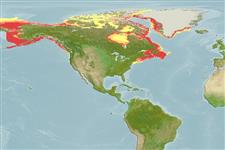>
Perciformes/Zoarcoidei (Eelpouts and pricklebacks) >
Zoarcidae (Eelpouts) > Gymnelinae
Etymology: Gymnelus: Gymnelus, derived from Greek, gymnēlos (Latinized Greek) = poor, needy (akin to Greek gymnos for destitute (E. Spencer, pers.comm. 09/13).; viridis: Name from Latin 'viridis' for green' in Latin, name given by O. Fabricius due to the colour of fishes, which live in a zone of macroalgae (Ref. 123905).
Environment: milieu / climate zone / depth range / distribution range
Ekologi
laut dasar (demersal); kisaran kedalaman 0 - 320 m (Ref. 50610). Polar; 84°N - 39°N, 180°W - 20°E
Arctic: Greenland and Canadian Arctic. Northeast Pacific: Bering Sea (Ref. 51665). Northern Atlantic: Canada and Barents Sea. Replaced by other species in the Arctic seas of Eurasia.
Length at first maturity / Size / Weight / umur
Maturity: Lm ?, range 10 - ? cm
Max length : 56.0 cm TL jantan/; (Ref. 4926)
Inhabits continental shelves, but generally living in shallower water (Ref. 11954); usually live over sand and muddy bottoms among seaweeds (Ref. 5951). Benthic; feeds on crustaceans, worms and clams (Ref. 58426).
Life cycle and mating behavior
Maturities | Reproduksi, perkembang biakan | Spawnings | Egg(s) | Fecundities | Larva
Anderson, M.E., 1994. Systematics and osteology of the Zoarcidae (Teleostei: Perciformes). Ichthyol. Bull. J.L.B. Smith Inst. Ichthyol. 60:120 p. (Ref. 11954)
Status IUCN Red List (Ref. 130435)
ancaman kepada manusia
Harmless
penggunaan manusia
Alat, peralatan
laporan khas
muat turun XML
Sumber internet
Estimates based on models
Preferred temperature (Ref.
123201): -1.5 - 4.8, mean -0.5 °C (based on 1722 cells).
Phylogenetic diversity index (Ref.
82804): PD
50 = 0.5002 [Uniqueness, from 0.5 = low to 2.0 = high].
Bayesian length-weight: a=0.00282 (0.00150 - 0.00530), b=3.19 (3.01 - 3.37), in cm total length, based on LWR estimates for this species & (Sub)family-body (Ref.
93245).
Trophic level (Ref.
69278): 3.1 ±0.26 se; based on food items.
Daya lenting (Ref.
120179): Rendah, Waktu penggandaan populasi minimum 4.5 - 14 tahun (tmax=12).
Fishing Vulnerability (Ref.
59153): Moderate vulnerability (42 of 100).
